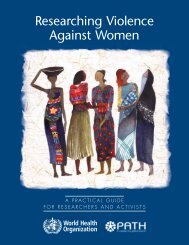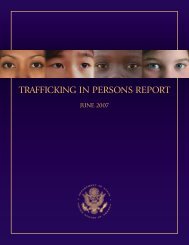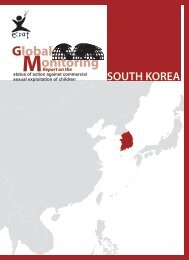Download PDF - Violence Against Children - East Asia and the ...
Download PDF - Violence Against Children - East Asia and the ...
Download PDF - Violence Against Children - East Asia and the ...
You also want an ePaper? Increase the reach of your titles
YUMPU automatically turns print PDFs into web optimized ePapers that Google loves.
The Philippines<br />
• conducting a range of creative learning<br />
activities on social issues that children want<br />
to learn more about, with 80% of <strong>the</strong> total<br />
membership of <strong>Children</strong>’s Associations<br />
participating<br />
• advocating on exploitative child labour/child<br />
abuse with <strong>the</strong> Provincial Child Welfare<br />
Council <strong>and</strong> <strong>the</strong> Department of Labor;<br />
children from <strong>the</strong> Associations have a role<br />
in a provincial “caravan” information<br />
campaign to combat child labour<br />
• assisting in barangay (village) Child<br />
Protection Council formation; providing<br />
orientation to six municipalities, one city<br />
<strong>and</strong> 250 public school teachers; raising<br />
awareness of teachers on child-related laws<br />
<strong>and</strong> cases of child abuse<br />
• supporting <strong>the</strong> implementation of <strong>the</strong><br />
<strong>Children</strong>’s Code<br />
• streng<strong>the</strong>ning children’s organisation at <strong>the</strong><br />
barangay, municipal, provincial <strong>and</strong> regional<br />
level so that <strong>the</strong>y are implementing <strong>the</strong>ir<br />
own plans<br />
• working to ensure that children are<br />
represented at all levels of government;<br />
this has included achieving membership of<br />
<strong>the</strong> Bohol children’s organisation in <strong>the</strong><br />
National Coalition of <strong>Children</strong> in <strong>the</strong><br />
Philippines.<br />
Useful approaches to<br />
building child participation<br />
World Vision’s Child Protection<br />
policy<br />
The international World Vision policy on<br />
Child Protection 7 has been adopted by<br />
World Vision Development Foundation<br />
(WVDF) Philippines, <strong>and</strong> a national version<br />
developed <strong>and</strong> shared with local NGO<br />
<strong>and</strong> <strong>Children</strong>’s Association partners. This<br />
has assisted <strong>the</strong> inclusion of planning for child<br />
protection as part of an integrated<br />
program design.<br />
The national World Vision policy will be<br />
fur<strong>the</strong>r localised in <strong>the</strong> districts. The Bohol<br />
World Vision team is drafting a child<br />
protection policy to this end, looking into<br />
critical provisions/areas in <strong>the</strong> existing policy.<br />
Advocacy includes support for <strong>the</strong><br />
information caravan/campaign on child labour<br />
initiated by <strong>the</strong> Department of Labor. The<br />
aim is to educate parents <strong>and</strong> government<br />
officials on <strong>the</strong>ir responsibility to protect <strong>the</strong><br />
children <strong>and</strong> to lessen, if not eradicate, child<br />
labour cases in <strong>the</strong> province.<br />
A dedicated National Child Protection<br />
Coordinator, assisting World Vision programs<br />
working on child protection issues to fur<strong>the</strong>r<br />
strategic partnerships <strong>and</strong> support<br />
implementation, is a significant resource for<br />
this process.<br />
The Bohol <strong>Children</strong>’s Code 8<br />
The <strong>Children</strong>’s Code is based on <strong>the</strong> CRC<br />
with its articulation of children’s rights closely<br />
following <strong>the</strong> four areas of survival,<br />
development, protection <strong>and</strong> participation.<br />
Of added significance is a section on<br />
responsibilities of <strong>the</strong> child, alongside rights, in<br />
<strong>the</strong> areas of:<br />
• leading a virtuous life<br />
• respecting <strong>the</strong> family<br />
• respecting elders<br />
• customs<br />
• laws<br />
• principles of democracy, <strong>and</strong><br />
• children’s responsibility to exert effort in<br />
<strong>the</strong> pursuit of development, participate in<br />
<strong>the</strong> community, <strong>and</strong> help observe human<br />
rights <strong>and</strong> freedom everywhere.<br />
The Code ascribes roles <strong>and</strong> responsibilities<br />
to different institutions such as family,<br />
education, media, judiciary, <strong>and</strong> local<br />
government. It details <strong>the</strong> responsibility of<br />
local authorities to plan for <strong>and</strong> fund<br />
comprehensive programs for young people.<br />
It contains policy for prevention programs at<br />
local level, parenting courses, health care,<br />
recreation, <strong>and</strong> crisis intervention. It goes on<br />
7<br />
See Appendix for a summary of <strong>the</strong> World Vision Partnership’s Child Protection Policy. WVDF’s adaptation of this policy is available in an online “Toolkit”<br />
appendix to <strong>Children</strong> at Risk, at http://www.children.campaign.org.<br />
8 More details of <strong>the</strong> Bohol <strong>Children</strong>’s Code are available in <strong>the</strong> online “Toolkit” appendix to this book (see previous footnote).<br />
60

















